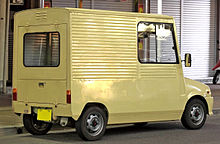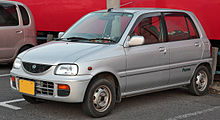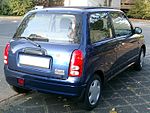- Daihatsu Mira
-
Daihatsu Mira 
Manufacturer Daihatsu Also called Daihatsu Cuore
Daihatsu Domino
Daihatsu Handi/Handivan
Subaru Pleo (second generation)Production 1980–present (now 7th gen.) Predecessor Daihatsu Max Cuore Class Kei car or City car Related Daihatsu Leeza
Daihatsu Move
Daihatsu Opti
Daihatsu Trevis
Perodua Kancil
Perodua Kelisa
Perodua VivaThe Daihatsu Mira (also known as the Cuore, Domino, and more recently Charade), is a kei car-type vehicle built by the Japanese car maker Daihatsu. It comes with a variety of options and chassis variations, with the latest variant having four models: "Mira", "Mira AVY", "Mira Gino" and "Mira VAN". The Mira is the latest successor to the line of cars begun with the Daihatsu Fellow of 1966 and was originally introduced as the commercial version of the Cuore. Outside of Japan, the Mira has also been offered with an 850 cc engine. In Australia, the two-seater version was known as the Handivan and was later renamed as just Handi.[1]
Contents
L55 series
Daihatsu Mira L55 
Also called Daihatsu Cuore
Daihatsu DominoProduction 1980.06–1985.08 Predecessor Daihatsu Max Cuore Body style 3-door Hatchback/Van
5-door HatchbackIn July 1980,[2] the Daihatsu Mira and Cuore arrived to replace the Daihatsu Max Cuore. A certain amount of confusion arises from the fact that this, the L55-series, was the first generation Daihatsu Mira but is considered the second generation of the Cuore. The second generation (L70) of the Mira/Cuore was introduced in 1985, and the third generation (L200) in 1990. The third generation of Mira also was identical in look to the 1986-1992 Daihatsu Leeza. The fourth generation (L500) was introduced in 1994 and was still based on the same chassis as the L200. October 1998 saw the fifth generation (L700) introduced, the sixth generation was introduced in 2002 (even though the Mira Gino (L700) remained in production until 2004), and in 2006 the seventh generation model was introduced.
The L200 variant (1990–92) had two engine sizes: a three-cylinder 660 cc engine with 40–64 PS (29–47 kW) was available in Japan, while in Australia and other parts of the world a bigger-hearted variant with a 847 cc and either a four or a five-speed manual gearbox was used. The L500 Mira is the first kei car from Daihatsu which offered a four-cylinder 660 cc engine.
L70 series
The second generation (L70) Mira/Cuore appeared in August 1985. It had a longer wheelbase and a new generation of three-cylinder engines replacing the previous two-cylinder (AB) versions. Displacement of the new EB engines remained exactly the same, at 547 cc. For the export versions an 847 cc three-cylinder was developed, called ED-10. In September 1986 a special version for the Swiss market appeared, with a narrower bore version displacing 796 cc (called ED-10A). Unlike the fractionally larger standard version, this one suited the four tax horsepower category in certain cantons, while other cantons had prominent tax limits at 800 cc.[3]
As for the domestic Japanese market versions, there were commercial versions (Mira) sold alongside passenger car versions (Cuore). The commercials had temporary rear seats which fold completely flat, and are easily recognized by luggage rails in the rear side windows. As for the previous generation, a version with switchable four-wheel drive was available for the "Van" version (chassis code L71V). The engines were originally carburetted, and either naturally aspirated or turbocharged (with intercooler). These offered 38 PS (28 kW) and 52 PS (38 kW) respectively.[4] The turbo version was only available as a Mira (three-door commercial), and was introduced two months after the regular version. Transmissions were either four or five speed manuals, with a two-speed automatic also available for the atmospheric versions.[5]
In January 1986, a five door "Van" (Mira) version was added. A "Walk-Through Van" version, using the regular bonnet combined with near square rear bodywork, appeared two months later. In August 1987, the Mira/Cuore received a minor facelift with a new grille and bonnet, as well as some other detail changes all making for a smoother appearance overall. Two months later a permanent four-wheel drive version was made available in the turbocharged version. After having undergone another minor change in October 1988, Japanese production of the L70 series ended when the new 660 cc L200 version was introduced in March 1990 in response to new regulations for the kei class.[5] This also marked the end of the division of the line into Mira and Cuore, as the Cuore nameplate was retired in Japan with the introduction of the new model.
Daihatsu's Thai arm carried on producing the L70 series after it was replaced in Japan. In addition to the regular version, they also developed a ute version for the pickup-hungry Thai domestic market from 1991 to 1995, called Mira P1. This was built with a pickup bed, tail gate and redesigned taillights. Coming full circle, and mirroring the development of the SUV, Daihatsu also developed the Mira P4: a roofed four-seater wagon version of this micro-ute. Some P4s retained the pickup's fold down tailgate, adding a top-hinged glass, while some had a top-hinged one-piece tailgate. Later, there was an extended cab 2+2 seater ute ("Daihatsu Miracab") and also a hatchback with an enlarged rear end, called the "Mint". While using the smaller engines as per the Japanese market, these were too long to be classified as true kei cars.
L200 series
The L200/201 was the third and thus far most popular generation of the vehicle, offered in a large number of variants. In the Japanese domestic market the "Cuore" name was dropped, as the differences between passenger and commercial versions were narrowed. The L200 (front-wheel drive) was produced with the Mira badge from the spring of 1990 until at least 1998, but the platform has lived on under other names. L201 was the chassis code used on export market cars, usually labelled "Cuore".
As with most Kei cars, the 200-series came in two primary variants: The "V" Series is a windowed van style intended for light commercial use. This variant featured a fold down rear bench seat without seat belts. The "S" series, intended for private use, is largely similar but the larger, more comfortable rear seats are equipped with belts and are further to the rear of the vehicle with more leg room. While the seats still fold down, unlike the "V", the "S" does not offer a flat loading floor. These characteristics are due to Japanese tax preferences for commercial vehicles, which only allow for temporary accommodation in the rear and demand a flat loading floor.
The Mira could either be equipped with a three-speed automatic, or four- or five-speed manual transmission. A four-wheel drive variant known as the L210 was also available in V or S models, only with the five-speed manual. An electronically fuel injected 12-valve (four per cylinder) turbo was the range topper, whereas the normally aspirated base versions made do with a one barrel carburetor. There was also a version with mechanical four-wheel steering, so far the only Kei car to feature this option.[6]
- Export
The L201 was sold outside of Japan primarily in Europe, Australia and New Zealand. The three or five-door 201 retained the larger displacement engine of 847 cc (ED10K) and a choice of four- or five-speed manual transmissions, or a three-speed automatic option. This carburetted engine produced 41 PS (30 kW) (ECE) at 5,500 rpm.[6] Van versions were also available in Australia, called Handivan (later shortened to Handi).[7] The Van, sometimes with filled in rear windows, was also marketed in certain other markets (such as the Benelux countries) where the tax structure favoured it.
The 200/201 had myriad market and model differences. Cuore badged L201's received a fog lamp on the left side. Later models of the Mira had fog lamps on both sides. The L201 had two license plate lamps while the L200 had only one. L200 Miras produced for Japan had no rear fog lamps, when sold in the United Kingdom (where Japan spec Miras were also available) they had a rear fog lamp mounted on the right hand side. Despite the Mira badge mostly being available in Right Hand Drive markets, left hand drive Mira-badged L201's was sold in the Dominican Republic.
This generation of the Mira was chosen by Malaysia's Perodua to become its first product. The L200 went on sale in Malaysia as the Perodua Kancil in 1994. After several facelifts, production of the Kancil finally came to an end in July 2009. The Malaysian built Kancil was marketed as the Daihatsu Ceria in Indonesia between 2000 and 2006.
A taller, highly customizable two-seat step-van variant ("Walk-Through Van") was also produced, solely for the Japanese market. This reached the maximum height allowed for kei cars, two metres.
L500 series
Production of the L500 Miras started in September 1994. The design of the car was slightly altered throughout but retained a look similar to that of the L200. The L500 Mira was badged outside of Japan primarily as the L501 Cuore. The 200 serie's Mira ceased sales in Japan but continued in some other markets, where it received the same engine updates as did the export market L500.
In the Japanese market the "Mira Moderno", a separate range of cars (non-commercials) was added in October 1995. This range received a minor facelift in May 1996, which was extended to the rest of the range in May 1997. In August 1997 the Mira Classic was added, a retro-look version. The Classic was available with naturally aspirated engines (40 PS/29 kW as a front-wheel drive, 55 PS/40 kW with 4WD) or a turbocharged option with 64 PS (47 kW). The Classic was not replaced, instead being succeeded by the Mira Gino. In January 1998, in cooperation with Sanrio, a "Hello Kitty" version of the Mira Moderno appeared. This was available in pastel colors and received various Hello Kitty details throughout the car, such as a Hello Kitty ignition key.
The L500 was Daihatsu's first kei class vehicle to feature a four-cylinder engine, with the option of the new JB series engine. When equipped with this engine, the model code became L502. The range of models available in the 200 platform more or less carried over to the 500 series. One change was that the export versions received fuel injection as standard, which brought the output of the 847 cc engine up by one, to 42 PS (31 kW). This engine was called the ED-20. The four-speed manual was no longer available, but a four-speed automatic joined the existing three-speed version in the domestic Japanese market.[8] In November 1996 a twin-cam, 12-valve version of the 847 cc three-cylinder was also made available. This, the ED-DE, produced 50 PS (37 kW) at 5,500 rpm.
In Australia the L500 Mira was sold as the Daihatsu Charade Centro. The model remains in production today only in Pakistan, as the Daihatsu Cuore. The L500 has rolled off the assembly line of Toyota Indus Motor Company since 2000, with the 847 cc carburetor engine (ED-10) which has been used in export models since 1986.[9]
L700 series
The fifth generation Cuore received the chassis code L700, with L710 being used for four-wheel drive versions. The new model appeared in the fall of 1998. While the engines of cars sold in the domestic Japanese market had to stay beneath the 660 cc threshold, export versions received a new larger engine: the 989 cc EJ-DE was a 12-valve DOHC three-cylinder, producing 56 PS (41 kW) at 5,200 rpm. Also new for export models was the availability of a three-speed automatic.[10] For some markets the 850 cc ED-DE engine was retained.
Production elsewhere
Production of the L700 Mira was picked up in Malaysia in 2001, where it was sold alongside the Kancil as the Perodua Kelisa with the familiar Daihatsu E-series engines of 660, 850, or 1000 cc. Perodua ended production of the model in 2007.
Mira Gino
A retro version of the Daihatsu Mira based on the L700 platform began production in 1999, replacing the preceding Mira Classic. The Mira Gino received features and options similar to those of the regular variant but was styled with a retro look. The Mira Gino was originally only offered with a 659 cc engine in Japan, but the 1-litre EJ-VE engine (as for the export market L700s) was briefly available in Japan as the Mira Gino 1000. A car based on the second generation Gino (which received its own modelcode of L650/L660) with a one-litre engine was sold as the Daihatsu Trevis in export markets.
L250 series
The L250/260 Mira, unrelated to the earlier 200-series, is the sixth generation of the car. The car is produced as the Mira in Japan. The L250 was labeled Daihatsu Charade in the United Kingdom. Elsewhere this was badged and sold as the Cuore. Export versions are L251, while L260 is used on four-wheel drive versions (for the Japanese domestic market only). After this was replaced in late 2006, the production line was shifted to Malaysia, where production of this car as the Perodua Viva commenced in May 2007.
In Japan there is also a sportier Mira Avy version available. The range underwent a very minor facelift in August 2005. A special handicap friendly (Mira Friend-Matic) version appeared in November 2006. This car could be driven directly from a special self-powered wheelchair (the "Mira Self-Matic"), with a drivers door that could open at 90 degrees and a fully automated entry and exit system. Buyers of the Self-Matic would receive government assistance. This version continued to be produced until August 2009.
L275 series
In December 2006 the L275, the seventh generation Mira, was presented. Originally only available as a passenger version, the Van derivative appeared in early 2007. As usual four-wheel drive versions received a different model code (L285). Japanese market cars received a new range of 660 cc engines featuring DVVT (Dynamic Variable Valve Timing), called the KF-series.
See also
- Perodua Kancil - A rebadged third/fourth generation of the Mira produced by Perodua.
- Perodua Kelisa - A rebadged fifth generation of the Mira.
- Perodua Viva - A rebadged sixth generation of the Mira.
References
- ^ Daihatsu Mira / Handi / Handivan Retrieved from www.microcarforum.com on 5 February 2009
- ^ "History of Daihatsu Kei Jidosha". xs4all.nl/~mjs/daihatsuk.html. http://www.xs4all.nl/~mjs/daihatsuk.html. Retrieved 2008-12-27.
- ^ Büschi, Hans-Ulrich, ed (March 5, 1987) (in German/French). Automobil Revue 1987. 82. Berne, Switzerland: Hallwag AG. pp. 240–241. ISBN 3-444-00458-3.. For the Swiss tax codes, see pp. 96-97.
- ^ Automobil Revue 1987, p. 240
- ^ a b (in Japanese) Car Graphic: Car Archives Vol. 11, '80s Japanese Cars. Tokyo: Nigensha. 2007. p. 249. ISBN 978-4-544-91018-6.
- ^ a b Büschi, Hans-Ulrich, ed (March 1991) (in German/French). Automobil Revue 1991. 86. Berne, Switzerland: Hallwag AG. pp. 233–234. ISBN 3-444-00514-8.
- ^ "Daihatsu Mira / Handi / Handivan". Microcar Forum. December 2, 2005. http://www.microcarforum.com/1980s/daihatsu-mira-handi-handivan.html.
- ^ Büschi, Hans-Ulrich, ed (March 6, 1997) (in German/French). Automobil Revue 1997. 92. Berne, Switzerland: Hallwag AG. pp. 231–232. ISBN 3-444-10479-0.
- ^ "toyota-indus". toyota-indus. http://www.toyota-indus.com/coure/. Retrieved 2011-09-23.
- ^ Nötzli, Max, ed (March 7, 2002) (in German/French). Automobil Revue 2002. 97. Berne, Switzerland: Büchler Grafino AG. pp. 247–248. ISBN 3-905-386-02-x.
External links
Daihatsu catalogues (Japanese):Current vehicles: Atrai/Hijet · Be-go/Terios · Boon/Sirion · Coo/Materia · Copen · Mira/Cuore/Charade · Mira Cocoa · Move · Tanto · Tanto Exe · XeniaPast vehicles: Altis · Applause · Bee · Ceria · Charade · Charmant · Compagno · Cuore · Consorte · Domino · Esse · Leeza/Leeza Spyder · Fellow Max · Max · Midget · Mira Gino/Trevis · Naked · Opti · Gran Move/Pyzar · Rocky/Feroza/Sportrak · Rugger/Rocky/Fourtrak · Sirion/Storia · Sonica · Taft/Scat · Taruna · Valera · YRVConcept Cars: ai · Basket · Copen (1999) · Costa · D-Bone · D-Compact X-Over · Deca Deca · Extol · EZ-U · FFC · HVS · Micros-3R · OFC-1 · SK-Tourer · SP-4 · U4B · UFE2 · UFE-III · X-021 · Mudmaster CRace Cars: P3 · P5Categories:- Daihatsu vehicles
- Kei cars
- 1980s automobiles
- 1990s automobiles
- 2000s automobiles
- Vehicles introduced in 1980
Wikimedia Foundation. 2010.















